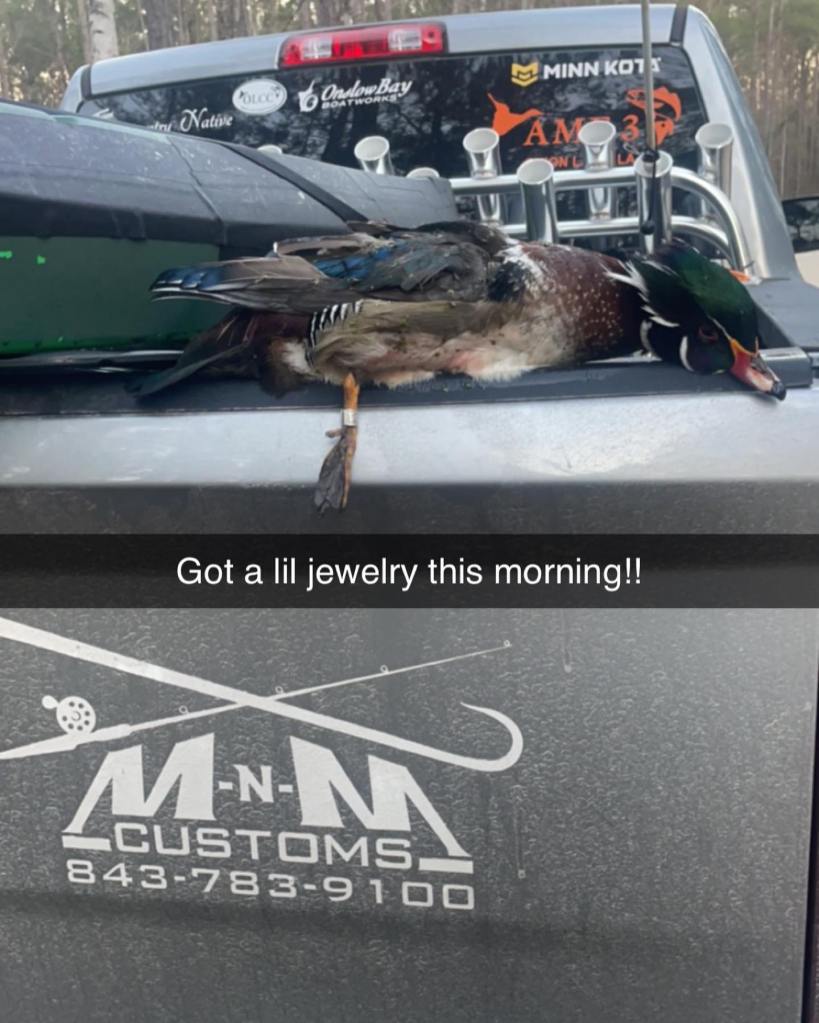S.C. outdoorsman kills wood duck banded 900 miles away in Louisiana
Published 7:00 am Wednesday, February 14, 2024

- Charleston, South Carolina, resident Martin Mouton, formerly of Lafayette, shot this male wood duck with a band on its right leg Jan. 30 while hunting approximately 30 miles from Charleston at the Francis Marion National Forest. The wood duck was banded in 2019 near Kaplan by Louisiana Department of Wildlife and Fisheries waterfowl program manager Jason Olszak. The national forest is approximately 900 miles from Kaplan.
After a 35-year-old Benelli Super Black Eagle 1 roared once early in the morning Jan. 30, Lafayette native Martin Mouton had a wounded wood duck on the water he quickly chased and killed before it could get away.
Mouton, 30, was surprised, pleasantly so, when he leaned over to pick up the wood duck, a drake. The woodie’s right leg had a silver band wrapped above its webbed foot.
That was unusual in itself because the odds of shooting a banded duck generally are listed, based on several reports, at 1 in 600. The unusual and fascinating part about the discovery in the swamp is that his only duck of the day was banded 4 1/2 years ago in Acadia Parish and Mouton was duck hunting public land 30 miles north of his hometown of Charleston, South Carolina.
What amazes him the most, he said, is the wood duck got its band in Kaplan, just 35 minutes from where he was born and raised hunting and fishing before moving to Charleston.
“When I saw that it was from Kaplan I thought, ‘Wow! That duck really was meant for me. I was glad I decided to get out of bed that morning and drive 45 minutes to the national forest,’ ” Mouton said.
How pumped up was the all-around outdoorsman, who already has three bands on his duck call lanyard, two from mottled ducks and one from a gray duck?
“When I saw ‘Kaplan, Louisiana,’ I said, ‘Yep, I’m done for the day!’ ” he said.
The wood duck was born in 2018 or earlier, according to the U.S. Geological Service., a branch of the Department of Interior. It was killed approximately 900 miles from where it was banded Sept. 25, 2019, by Louisiana Department of Wildlife and Fisheries veteran waterfowl biologist Jason Olszak.
There were several milestones notched that day by Mouton, the son of Henry Mouton of Lafayette and Bettina Wilson of Charleston. He detailed those memorable firsts as the first duck he’s harvested in the Francis Marion National Forest since Dec. 12 (also his first duck of 2024) and the first banded duck he’s ever shot in South Carolina.
Since moving to Charleston, in January 2016, he has hunted ducks on public land since the 2017-18 waterfowl hunting season in South Carolina.
“I didn’t know what I was getting into. I’m still trying to figure it out,” he said.
In other words, it’s been challenging to pattern and find the ducks there.
Mouton also hunts in Acadiana for three weeks every year around Christmas time with his father, also an all-around outdoorsman. They are guests of New Iberia native Dr. Eric Elias, Elias’ brother, Dr. Darryl Elias Jr. and their father, New Iberian Dr. Darryl Elias Sr., who hunt ducks around Pecan Island and elsewhere below the Intracoastal Waterway. (The Elias family and friends killed a total of 915 ducks, one goose and a deer in 2023-24, Mouton said.)
He enjoyed some rewarding duck hunts this past season in southwest Louisiana where he killed a total of 85 ducks and nine wild hogs and also caught beaucoup redfish and blue catfish averaging 5 to 8 pounds. Once again it was the highlight of his winter.
The harbor master at Safe Harbor Bristol Marine returned to Charleston on Jan. 6 and the next day scouted Francis Marion National Forest, which hasn’t been kind to him as far as productive duck hunting. The water was up 2 feet in the swamp when he got back from his home state, which made it more difficult for him to get around and scout.
On many of his subsequent scouting trips he’d always see a pair of wood ducks fly into one area about the same time every morning. He kept that in mind as a potential duck hunting area as he hunted down the stretch of January.
Mouton got to his spot to hunt just before 7 a.m. Jan. 30 carrying his trusty Benelli. Like clockwork, the wood duck couple dropped onto the water. He shouldered his shotgun and fired. The hen fled while the crippled male wood duck skipped across the water in a hurry seeking cover.
Mouton intercepted it.
How did a wood duck banded in the Mississippi Flyway wind up in the Atlantic Flyway?
Intrigued, Mouton’s dad, Henry Mouton, sent a message that day to Olszak, the veteran waterfowl biologist who banded the bird in 2019.
Olszak, now the waterfowl program manager for LDWF, replied and said he wasn’t surprised it was an adult male that made that long flight, noting ducks start pairing up in the wintering grounds and males follow the hens back to the general area they either hatched or had successful nests in the past if it’s an older hen.
Mouton’s banded duck likely hooked up with an Atlantic Flyway hen a year or two ago, then spent the spring(s)/summer(s) somewhere across Canada’s vast nesting grounds before migrating south with the Atlantic Flyway flock.
Olszak wrote: “It is a true rarity for one of our banded hens to be harvested very far from her banding location and when it does it’s likely an early migrant that we happened to band in September or early October. But it’s one of those things that hasn’t been studied yet.”
Drakes are different, obviously. The woodie wearing Band 1245-51489 proved that.
More than 200,000 ducks and 100,000 geese are banded each year In North America. The bands provide valuable information for waterfowl managers. Duck hunters play a crucial role by reporting band recoveries that help researchers track patterns.
Mouton has added a chapter to his waterfowl hunting days that began at age 5 when his dad took him whenever both got invites to the old Oak Grove Lodge, which was blown away during Hurricane Rita in 2005.
The Oak Grove Hunting Club was created by Lafayette oilman and avid outdoorsman Win Hawkins. The original lodge was destroyed by Hurricane Audrey in 1957.
Mouton has fond memories of those early duck hunting days and subsequent trips. He plans to mount that Kaplan-banded duck, frame the USGS certificate and add a replica band to his duck call lanyard.
That bird was special.
“It felt really good after all the unsuccessful hunts” – 16 trips, to be exact — without pulling the trigger while duck hunting inside the scenic national forest, he said.





